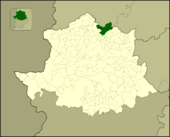Valle del Ambroz
| Valle del Ambroz | |
|---|---|

|
|
| Location of the comarca in the province of Cáceres | |
| Basic data | |
| Province: | Cáceres |
| Main place: | Hervás (Cáceres) |
| Surface: | 234.46 km² |
| Residents: | 7571 (2019) |
| Municipalities: | 8th |
Valle del Ambroz is the name of the river valley of the Río Ambroz and at the same time the name of a comarca in the north of the province of Cáceres in the autonomous region of Extremadura in western Spain .
landscape
The hilly to mountainous and very wooded landscape of the Valle del Ambroz is located at altitudes of around 450 to 1800 meters. The highest place is La Garganta at about 1124 meters above sea level. d. M .; the deepest is Abadía with a height of only 453 meters above sea level. d. M.
Municipalities ( municipios )
| Municipio | population | surface | Population density | Height above d. M. |
|---|---|---|---|---|
| Abadía | 328 | 45.08 | 7.28 | 453 |
| Aldeanueva del Camino | 784 | 19.70 | 39.79 | 524 |
| Baños de Montemayor | 769 | 21.98 | 34.98 | 700 |
| Casas del Monte | 814 | 27.61 | 29.48 | 598 |
| La Garganta | 482 | 24.08 | 20.01 | 1124 |
| Gargantilla | 432 | 20.87 | 20.69 | 642 |
| Hervás | 4,197 | 59.78 | 70.02 | 688 |
| Segura de Toro | 196 | 15.36 | 12.76 | 636 |
| Valle del Ambroz | 8,002 have. | 234.46 km² | 34.2 hab / km² |
economy
Agriculture and animal husbandry have shaped the face of the Valle del Ambroz since time immemorial - cherries and chestnuts are planted as well as vegetables (especially peppers). In the last decades of the 20th century, the comparatively water-rich and cool region acquired a certain tourist importance.
history
The valley of the Río Ambroz is part of the Via de la Plata , an important north-south connection on the Iberian Peninsula that was already well developed by the Romans ; Today the former national road N630 runs here, most of which has been expanded into the A-66 autovía and connects the Asturian coastal city of Gijón with the Andalusian capital Seville .
Until the great territorial reform of Spain in 1833 under Francisco Javier de Burgos , the northeastern part of today's comarca still belonged to the Comunidad de villa y tierra de Béjar , hence to Castile-León ; the south-western part, however, belonged to the Comunidad de villa y tierra de Plasencia - for this reason some places have two parish churches.
Attractions
Apart from its wooded surroundings, the small town of Hervás with its former Jewish quarter (Spanish: judería ) is particularly worth a visit, but the other villages also offer charming and historical aspects.
